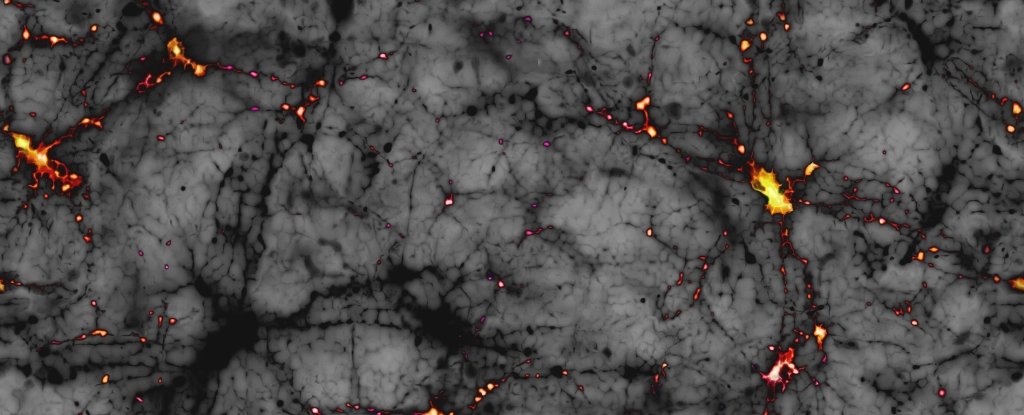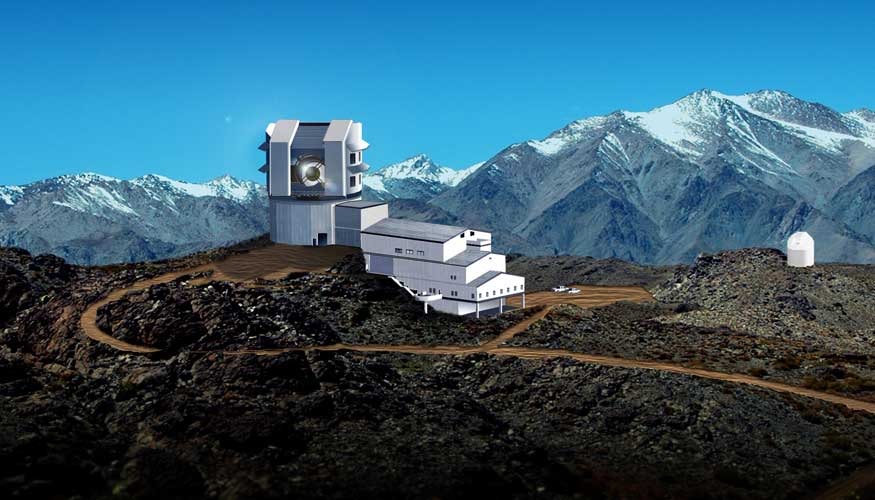via
4 MAR 2020
MICHELLE STARR

(Mark Garlick/Science Photo Library/Getty Images)
Something in the Universe is creating more mass than we can detect directly. We know it’s there because of its gravitational effect on the stuff we can detect; but we don’t know what it is, or how it got here.
We call that invisible mass Dark Matter [see Dark Matter Background below], and physicists have just identified a particle that could be behind it.
The candidate culprit is a recently discovered subatomic particle called a d-star hexaquark. And in the primordial darkness following the Big Bang, it could have come together to create dark matter.
For almost a century, dark matter has perplexed astronomers. It was first noticed in the vertical motions of stars, which hinted that there was more mass around them than what we could see.
We can now see the effect of dark matter in other dynamics, too – in gravitational lensing, for instance, wherein light bends around massive objects such as galaxy clusters; and the outer rotation of galactic discs, which is too fast to be explained by visible mass.
Dark matter has, so far, proven impossible to detect directly, as it neither absorbs, emits, nor reflects any kind of electromagnetic radiation. But its gravitational effect is strong – so strong that as much as 85 percent of the matter in our Universe could be dark matter.
Scientists would very much like to get to the bottom of the dark matter mystery, though. It’s not just because they’re very nosy – figuring out what dark matter is could tell us a lot about how our Universe formed, and how it works.
If dark matter doesn’t actually exist, that would mean there’s something very wrong with the standard model of particle physics we use to describe and understand the Universe.
There have been a number of dark matter candidates put forward over the years, but we still don’t seem to be much closer to finding an answer. This is where the d-star hexaquark – more formally, d*(2380) – enters the picture.
“The origin of dark matter in the Universe is one of the biggest questions in science and one that, until now, has drawn a blank,” explained nuclear physicist Daniel Watts of the University of York in the UK.
“Our first calculations indicate that condensates of d-stars are a feasible new candidate for dark matter. This new result is particularly exciting since it doesn’t require any concepts that are new to physics.”
Quarks are fundamental particles that usually combine in groups of three to make up protons and neutrons. Collectively, these three-quark particles are called baryons, and most of the observable matter in the Universe is made of them. You’re baryonic. So’s the Sun. And the planets, and space dust.
When six quarks combine, this creates a type of particle called a dibaryon, or hexaquark. We haven’t actually observed many of these at all. The d-star hexaquark, described in 2014 [Physical Review Letters], was the first non-trivial detection.
D-star hexaquarks are interesting because they’re bosons, a type of particle that obeys Bose-Einstein statistics, a framework for describing how particles behave. In this case, it means that collection of d-star hexaquarks can form something called a Bose-Einstein condensate.
Also known as the fifth state of matter, these condensates form when a low-density gas of bosons is cooled to just above absolute zero. At that stage, the atoms in the gas go from their regular wiggling and jiggling to quite still – the lowest quantum state possible.
If such a gas of d-star hexaquarks was floating around in the early Universe as it cooled in the wake of the Big Bang, according to the team’s modelling, it could come together to form Bose-Einstein condensates. And those condensates could be what we now call dark matter.
Obviously this is all highly theoretical, but the more dark matter candidates we find – and confirm or rule out – the closer we are to identifying what dark matter is. And aren’t you just dying to know?
So, there’s more work to be done here. The team is planning to search for d-star hexaquarks out there in space, and to test their current work to see if they can break it. They’re also planning to conduct more work on d-star hexaquarks in the lab.
“The next step to establish this new dark matter candidate will be to obtain a better understanding of how the d-stars interact – when do they attract and when do they repel each other,” said University of York physicist Mikhail Bashkanov.
“We are leading new measurements to create d-stars inside an atomic nucleus and see if their properties are different to when they are in free space.”
The research has been published in the Journal of Physics G: Nuclear and Particle Physics.
________________________________________
Dark Matter Background
Fritz Zwicky discovered Dark Matter in the 1930s when observing the movement of the Coma Cluster., Vera Rubin a Woman in STEM denied the Nobel, did most of the work on Dark Matter.


In modern times, it was astronomer Fritz Zwicky, in the 1930s, who made the first observations of what we now call dark matter. His 1933 observations of the Coma Cluster of galaxies seemed to indicated it has a mass 500 times more than that previously calculated by Edwin Hubble. Furthermore, this extra mass seemed to be completely invisible. Although Zwicky’s observations were initially met with much skepticism, they were later confirmed by other groups of astronomers.
Thirty years later, astronomer Vera Rubin provided a huge piece of evidence for the existence of dark matter. She discovered that the centers of galaxies rotate at the same speed as their extremities, whereas, of course, they should rotate faster. Think of a vinyl LP on a record deck: its center rotates faster than its edge. That’s what logic dictates we should see in galaxies too. But we do not. The only way to explain this is if the whole galaxy is only the center of some much larger structure, as if it is only the label on the LP so to speak, causing the galaxy to have a consistent rotation speed from center to edge.
Vera Rubin, following Zwicky, postulated that the missing structure in galaxies is dark matter. Her ideas were met with much resistance from the astronomical community, but her observations have been confirmed and are seen today as pivotal proof of the existence of dark matter.





See the full article here.
five-ways-keep-your-child-safe-school-shootings
Please help promote STEM in your local schools.

